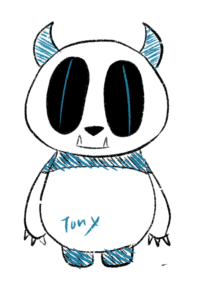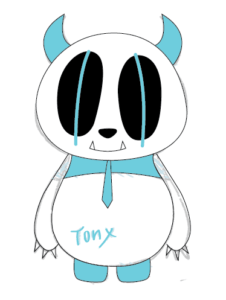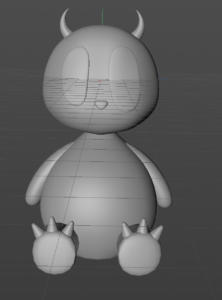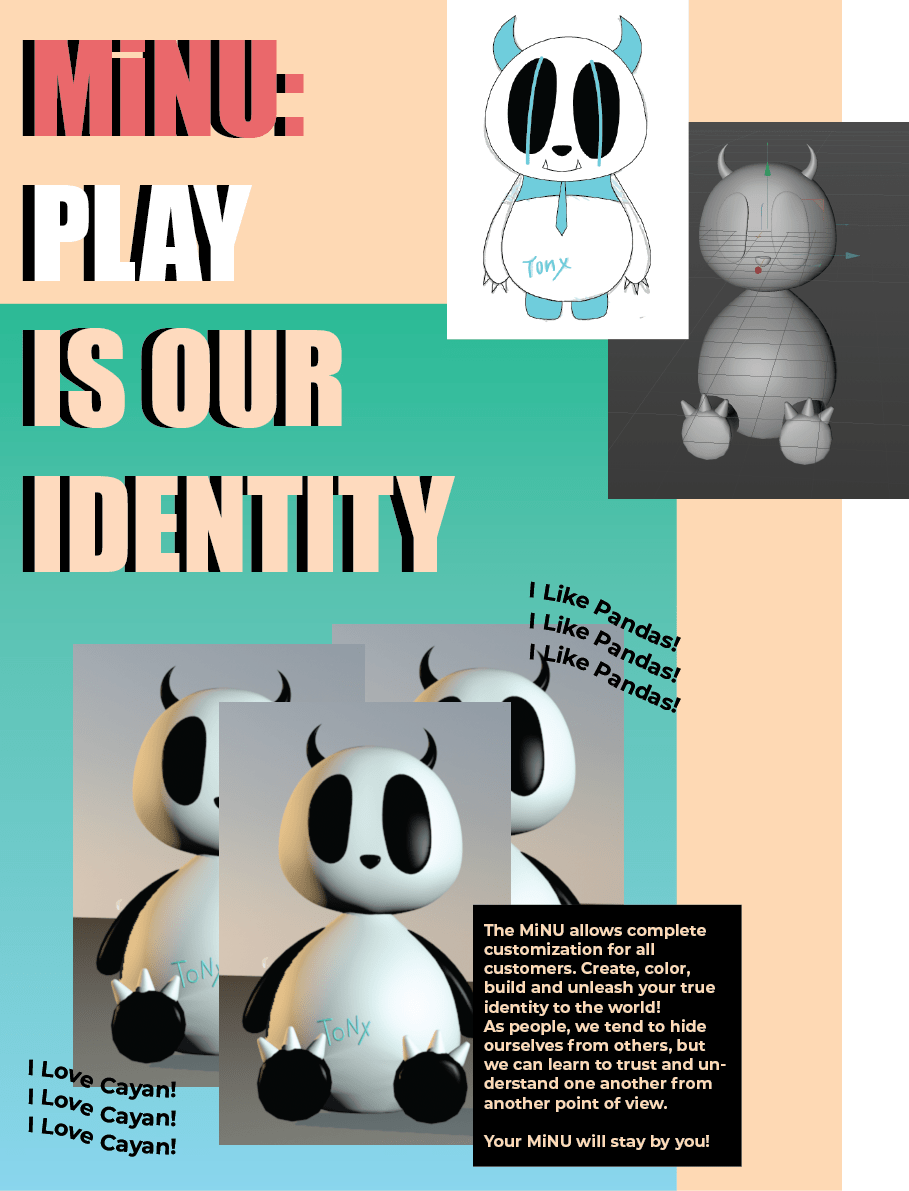Part 01: The Reflection
- What Is Your Project? Who Is It For?
- The name of my project is MiNU. The name stems from a number of different play on words such as, “Me and You” and “Mini U”. It is a project targeted at the creation of a toy, a figurine for customers to customize and best represent themselves in cartoon form. The idea for the line of MiNUs began through the interview I conducted with my older brother, Tony. He expressed that there was a lack of personal customization in the field of toys he admired, answers that ultimately helped cultivate the strong aspect of customization in this particular project. The MiNU was also in part, inspired by the vinyl toy/figurine designs in today’s market, including but not limited to FUNKO POP and MIGHTY MUGGS. The idea was to move away from the references and preservation of pop-culture related fandoms and place the focus on the customers themselves. The attributes of this particular MiNU design fall in line with the characteristics and interests of Tony. He likes Cyan Blue, his favorite animal is the panda and he believes that the Pokemon, Snorlax, best represents him through pop-culture means.
- My brother enjoys collecting the aforementioned FUNKO POPS and currently owns a collection of 447 figurines! He often stacks the toys on top of one another, reviewing them and featuring them in certain social media videos. This is what he claims as his version of ”playing” with them. I expect that my brother would do the same with the MiNU I have created for him. Due to the circumstances of the current situation, I am unable to post a video to reference the play experience of my interviewee.
- What Is Play?
- In the documentation post describing my personal definition of play, I mentioned my agreements with the various readings we were assigned. I mention how I believe that “play is neither a fixed situation of seriousness nor non-seriousness”, a belief I formed through the help of both Peter Gray’s “Play Makes Us Human I: A Ludic Theory of Human Nature” and Johan Huizinga’s “Homo Ludens”. I wanted to apply this aspect of the voluntary experience of fun through the project, hence the theme of customization.
- What inspired me the most when creating the entire project was, in fact, Gray’s lecture on the innate benefits of play on human beings and the basis of play as a function of the biological and cultural being. Gray states that play is capable of various things, including but not limited to acting as the means of promoting cooperation, creativity, and education. He mentions that “when we bring playfulness to bear in our social interactions we create a spirit of equality and personal freedom that … overcomes our equally human drive to dominate one another” (10). The state of play ultimately cultivates a moment of mutual understanding, of respect and of equality, which suppresses aggression between humans as a whole. This aspect is translated through my wishes of the MiNU becoming a source of play for people to understand one another better and grant access for that ability to overcome the dominating drive of a human being.
- Furthermore, Gray believes that play is “creative behavior deriving from within”, in which “it is representative” of the players and the action (12). With this basis for the higher culture in art and creation, I reinforced the idea of pure customization and creative freedom within the project.
- Lastly, it is stated within “The Ludic Theory of Play” that play works fundamentally as a basis for education. In that, the human is a “cultural being, and education is the passing of culture” and information between people (15). The aspect of play ultimately functions as the vehicle for a person’s education. This final aspect of education is intertwined with the previous lessons of play and is integrated into my MiNU project with the theme of mutual understanding and education into the lives of those who surround us and those we care dearly about.
- Reflection and Wishes
- Through the process of Project 2, I really learned that I still have a long long way to go in the realm of 3D modeling. I learned that just as much as any other project or creation, the process of preparation is extremely important. What I believe went well was my perseverance through difficult periods, in which I would get extremely frustrated at the application or even myself when things did not happen as I had planned them to, but I would continuously pull through with what I had. I believe that I was able to use my resources to the best of my abilities, by accessing various tutorials online and using geometric solids to my advantage. I also do think that I have come a long way since my understandings of C4D at the beginning of the semester. At first, I could not fully understand the logistics of the Subdivision Surfaces, and how they impacted the original solid shapes. The understandings of the tools only hit me during the modeling phase of this project.
- What didn’t work so well was the transition from paper to real-life creation. I had so many ideas mapped out but was only able to achieve a number of them in the modeling phase. Plans changed and I had to compromise in various sections of the project, as I mentioned in my presentation last week. I wish that I could have completed the project as I first wanted. I also had difficulty with the preparation of the model for 3D printing, despite having followed directions and written thorough notes on each step provided during the lecture. I had most difficulty with the Magic Merge as it would sometimes cause strange lacerations and dents to appear in my, overall, smooth design. This is something I am curious to know more about and learn more about.
- I do believe that I am also still lacking in the aspect of toy design itself, given that I have never been a big fan of ‘traditional toys’ but more of video games and board games. I believe that I need to expose myself to more real-life examples and variating choices.
- If I was given the luxury of more time, I would most definitely first become more familiar with the process and logistics of 3D Modelling. I was really blown away by some of the work my peers created and presented, and thought that if only I had more experience and more time to polish my skills I could have created something that was much more intriguing. Furthermore, if I had this experience and more time, I would choose to make a toy that was more functional. I would like for my creation to have movement and to be able to adapt to its surroundings better. I would also love to take the opportunity of combining several skills, such as my classmates who utilized their interests in Adobe Illustrator for not only their sketches and line work but also full renditions of modeling parts.
Part 02: The Process (Portfolio Version)
- I first created the base sketch of the toy in the OS application known as ProCreate with my iPad Pro and iPad Pencil.

2. I cleaned up the initial sketch with linework in Adobe Illustrator. This created clean cut edges in place of the rough design.

3. I then recreated the design as a model in Cinema 4D.
-
- For the most part, I utilized the Subdivision Surfaces, Cubes, Cones, Capsules, Bend Tools, Loop Cuts, Symmetry, and Boole Tools
- My interviewee and I both decided that, in the end, the original cyan blue design would prove to be too bright when printed, and so I substituted the colors for a black and white aesthetic. In order to make up for the lack of cyan, I allowed the text “Tony” to remain in the shade of blue in order to provide a pop of color.

4. Lastly, I created the final poster for the project through Adobe Illustrator.
-
- I utilized the functions of text, path text, rectangle tool most and uploaded renders of the project at each stage to integrate them into the final poster.

References:
-
- Gray, Peter. “Play Makes Us Human I: A Ludic Theory of Human Nature.” Psychology Today, Psychology Today, 4 June 2009, www.psychologytoday.com/ca/blog/freedom-learn/200906/play-makes-us-human-i-ludic-theory-human-nature.














Hi Celine,
in regards to Magic Merge and your question about how it works.
This is a script to perform what we would do by using a Boolean operation, then we make the boolean editable and finally connect the objects together (select objects, right click, and select menu “connect+delete”). Sometimes it’s better to do it manually, because we need to be careful with the polygons we are creating. When is not working it might be that the objects are not solid or they have issues with polygons overlapping or something like that, therefore magic merge wont work.
It is always good to know this to understand what’s happening. I probably failed to deliver some of these concepts in advance, teaching completely online is not something I master, and I wanted you to practice first without overwhelming you with information. Learning a 3D software is not easy nor fast and probably this is just a successful starting point.